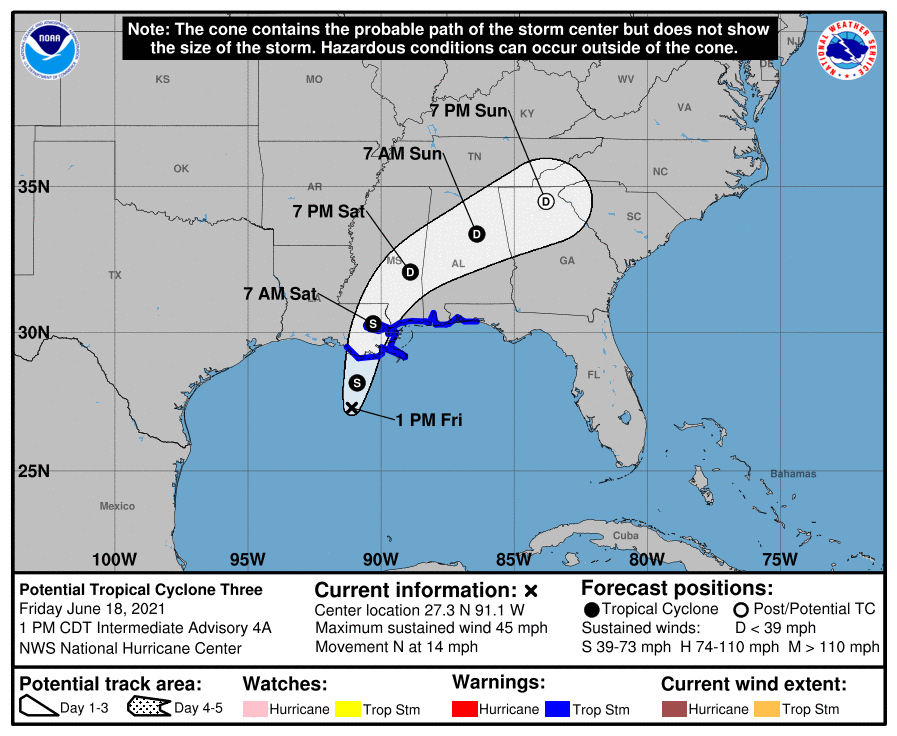Two Tropical Storms Take Form Near U.S.
Jun 18, 2021
A little more than two weeks have past since the start of the Atlantic hurricane season and as of Thursday, June 17th, two named tropical storms were forming off different coasts of the U.S. –- Tropical Storm Bill, which skirts the east coast and Tropical Storm Claudette, which threatens the Gulf states.
Bill formed several hundred miles off the coast of Virginia and North Carolina on Monday, June 14th. By Tuesday morning the storm was about 420 miles east of Nantucket, Massachusetts with maximum sustained winds of 60 mph, according to the National Hurricane Center. It was traveling toward the northwest at a forward speed of 38 mph.
Bill is not expected to threaten the U.S., but will whip up waves offshore, affecting shipping lanes and sites that are popular for fishing. This storm is expected to have a short life.
Landfall is not expected in the U.S. due to a developing southward dip in the jet stream located in the Northeast. These conditions are expected to push the storm away at increasing speed during Wednesday and Thursday. It will then travel over colder water, which is expected to kill it.
Tropical Storm Claudette developing in the Gulf of Mexico is expected to become a greater storm as it threatens to plummet southern states with torrential rain.
Clouds, showers and thunderstorms have been forming and dissipating over the southwestern Gulf of Mexico since last week. Hurricane experts with AccuWeather guess that this storm will not be too strong. The reason is that wind shear north of the storm is expected to be high, will slow the storm’s movement toward the north and cause the top of the thunderstorms to be blown off.
Wind shear is the change in the strength or direction of breezes at high altitudes or over horizontal areas above the Earth’ surface. When wind shear is high or increases, it can cause a reduction of the storm system thus reducing its strength. As a result, it is expected to remain a tropical storm.
The wind shear and dry air may help to keep the rain away from much of the Texas coast, except perhaps in the region northeast of Galveston Bay. This is expected to force the tropical storm to drench Louisiana, Mississippi, Alabama, and the Florida Panhandle starting as early as Friday and lasting maybe into early next week.
How much rainfall will depend on the path and force of the storm. A moderate tropical storm may direct heavy rain in concentrated areas. A poorly organized storm system could cause a spreading out of the rain over a wider area with lower rain accumulation.
If the storm tracks into Louisiana or southern Mississippi there may be more rain along the central and northeastern Gulf Coast. If the storm heads for the Texas and Louisiana border then there is a chance of heavier rains as far west as the upper Texas coast and across southwestern Louisiana.
Much of the area has already been saturated with rain. Heavy rain last week pelted parts of the South Central states causing some flooding. A region stretching from the central Texas coast to southern Louisiana as well as sections of Mississippi suffered up to 1 to 2 feet of rain since the beginning of May. Ground conditions there and through to the north of Arkansas and Tennessee and farther to the east in Alabama and Georgia is already saturated. So the area is susceptible to flooding should there be more rainfall.
As much as 20 inches of rain may strike the Gulf States due to Claudette. Weather conditions are anticipated to worsen from the upper Texas coast through the Florida Panhandle on Friday. There is a chance of tropical storm conditions into the weekend.
Areas around the central Gulf Coast from New Orleans eastward to Mobile Bay may have to contend with isolated to widely scattered tornadoes.
With the 2021 hurricane season upon us, you may want to consider the purchase of a standby generator if you don’t already have one. APElectric has an inventory of generators from some of the most popular manufacturers in the country. Many of them feature Wi-Fi, which allows you to control them from any location on earth. For more information on the generators now available and how to choose the proper generator for your needs, call 847-516-8882 or visit the APElectric website.
For complete forecast visit https://www.nhc.noaa.gov/
